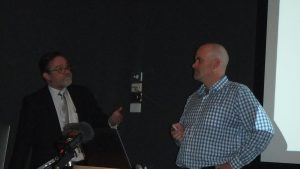Meeting Report
DSP Audio Upgrade at the Melbourne Convention & Exhibition Centre
On Monday October 9th Matt Edgcumbe, National Operations Manager of Rutledge AV, and Michael Walker, Equipment and Infrastructure Manager of MCEC, gave us a presentation on the work that Rutledge and the MCEC staff have been doing over the past few years on upgrading the audio infrastructure in the complex.

Matt started with a brief overview of Rutledge AV as a company, and then Michael gave an overview of the MCEC complex. This was followed by Matt providing an overview of the Convention Centre user and back-of-house spaces, their functions and configurations. He and Michael also covered the digital signage system and the facility-wide PA and EWIS (Emergency Warning and Intercommunication) systems.
Matt then explained that in 2009 the Convention Centre was opened and mentioned that the AV systems in the original Exhibition Centre (“Jeff’s Shed”) were refurbished not long after that.
He then covered the site-wide digital video upgrade that was done in 2014, along with the upgrading to a fibre cabling infrastructure, and an end-user control surface upgrade to a more user-friendly interface for commonly used core functions. Michael expanded on this upgrade and the benefits it brought to both the client users, and to MCEC staff, and finally describing the original Biamp Audia Flex DSP devices.
Michael then moved on to describe that the current MCEC facilities include over 60,000 square metres of event space over 42 meeting and event spaces hosting over a thousand events per year with over a million attendees per year. He revealed that over the rebuild shutdown period they still achieved an over 80% occupancy rate.
He then described the previous system’s use of the Cobranet protocol. Being a Layer 2 system, he explained, meant that it could not be segmented, so errors in one area could propagate throughout the system – giving the example that a failure, for example, of a UPS in one room could crash systems throughout the facility. He recounted that they had to implement a recovery protocol involving a code-word on the comms network that triggered a rapid response of support staff to reset all the Satellite Control Room DSPs. Stability and reliability improvements were cited as key drivers for latest change, together with improvements to the user experience.
Michael described how they settled on a system using BSS components networked via Dante, which being Layer allows system malfunctions to be isolated. He also commented that, despite being a proprietary system, Dante’s availability across a wide range of equipment, particularly audio consoles, makes it eminently suitable for their application where clients may want to bring in and connect their own audio consoles.
Matt then described the installation challenges, involving having to schedule around existing bookings whilst maintaining central services on both the old and new systems.
He then described the process of decommissioning the Biamp Audia Flex and installing the BSS BLU-806 and 326 boxes – displaying a system-wide block diagram, and describing the various elements of the system.
He described the outcome for the MCEC as a standards-based network topology, with increased flexibility, connectivity, management, and monitoring via the network – and a venue-wide distributed audio over IP system.
The evening concluded with a Q&A, covering a diverse range of topics – like their experience with reliability improvement, Dante management and network security, touch-screen redesign, and power redundancy.
A video has been assembled of the talk, covering the Powerpoint slides+audio:
This video can also be viewed directly on YouTube at:
https://www.youtube.com/watch?v=L9fgKtydxKk
A PDF copy of the slides presented can be viewed or downloaded here.
and
The audio-only recording can be heard or downloaded here.
Thanks to Graham Haynes and his trusty Tascam for the audio recording.
A special thanks to the SAE Institute for the use of their excellent facilities.
